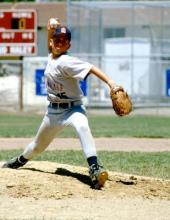Delaying single-sport specialization until late adolescence not only minimizes the risks of overuse injuries and burnout, but it increases the likelihood of athletic success, according to a new clinical report from the American Academy of Pediatrics.
The new report gives pediatricians a current knowledge base to draw upon in well checks and sports injury visits, author Joel S. Brenner, MD, MPH, of the AAP’s Council on Sports Medicine and Fitness, said in an interview.
Specializing in a single sport at younger ages – and playing intensively year-round – has become increasingly common, and is often driven by aspirations for college scholarships or elite athletic status. Yet evidence suggests that early specialization may actually work against such goals.
Studies of top college athletes and reviews of other elite athletes and their specialization history show that “for the majority of sports, late specialization with early diversification [playing multiple sports early] is most likely to lead to elite status,” the report states (Pediatrics. 2016;138[3]:e20162148).
Youth who participate in a variety of sports until late adolescence (about 15-16 years of age) also have fewer injuries and a higher chance of remaining engaged in sports for the long term than do children who specialize early, according to the guideline. “Unfortunately, 70% of children drop out of organized sports by 13 years of age.”
If a young athlete has decided to specialize in a single sport, you should discuss his or her goals to determine if they are appropriate and realistic. A mere 1% of high school athletes receive athletic scholarships and only 3%-11% go on to compete at college level; of high school athletes, only 0.03%-0.5% proceed to the professional sports level, the report notes.
Having at least 1-2 days off per week from the focal sport can decrease the chance of injury, and taking 1 month off at least 3 times a year “will allow for athletes’ physical and psychological recovery.”
An estimated 50% of athletic injuries are related to overuse. The physiologic and psychological effects of intensive training in young athletes are detailed in other articles by the AAP (Pediatrics. 2007;119[6]:1242-5) and the American Medical Society for Sports Medicine (Clin J Sport Med. 2014;24[1]:3-20).
According to a 2008 report from the National Council of Youth Sports, 27% of the youth active in adult-led organized sports participated in only 1 sport. “There is increased pressure to participate at a high level, to specialize in one sport early, and to play year-round, often on multiple teams,” the guideline notes.
This clinical report replaces the academy’s 2000 policy statement on sports specialization and intensive training and provides “concrete guidance” for pediatricians, said Dr. Brenner, who is medical director of Children’s Hospital of the King’s Daughters’ sports medicine and adolescent medicine programs and the director of CHKD’s sports concussion program, in Norfolk, Va.
There was no external funding for this report and the authors had no relevant financial disclosures.


